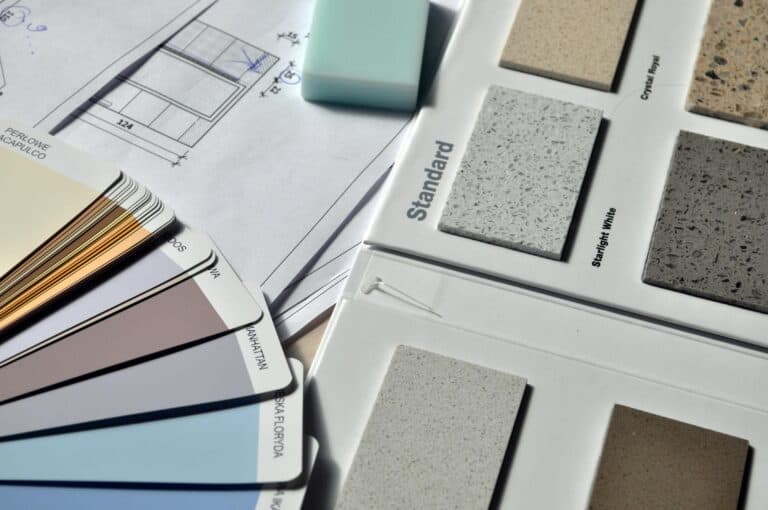Balancing durability, cost, and aesthetics is a primary challenge when specifying partition materials. This article provides a direct comparison of five premium options to aid in that decision.
Wood Veneer
Best For: Environments where warmth, sophistication, and a natural aesthetic are the primary goals, such as executive offices, private clubs, or upscale restaurants.
What It Is: Wood veneer partitions are created by applying a thin layer of real wood to a substrate core. The entire component is then sealed with a high-performance catalyzed conversion varnish for protection.
Key Characteristics:
- Natural Elegance: Provides the unmatched warmth, grain, and depth of real wood, creating a rich and sophisticated atmosphere.
- Aesthetic Uniqueness: Each veneer has a distinct grain pattern, ensuring that no two installations are exactly alike.
- Controlled Environments: While sealed for protection, wood veneer is not recommended for high humidity or high abuse environments. It is a material chosen for its aesthetic impact in controlled settings.
Compact Laminate (Phenolic)
Best For: High traffic, high humidity environments where beauty, longevity and minimal maintenance are the highest priorities, such as schools, airports, stadiums, and pool houses.
What It Is: Compact Laminate is a high pressure structural laminate made of three core components: a central core of phenolic impregnated craft paper, a decorative layer with the specified design, and a protective wear layer. These layers are fused together under intense heat and pressure to create a single, solid, and exceptionally durable panel with a non-porous finish.
Key Characteristics:
- Exceptional Durability: The dense core of Compact Laminate provides superior resistance to impact and scratches.
- Water Resistance: Its non-porous nature makes it highly resistant to moisture, humidity, and steam, preventing warping or delamination.
- Design Versatility: While known for its strength, Compact Laminate offers a clean, modern look and is available in a wide range of colors and patterns.
- Superior Fire Rating: Compact Laminate typically boasts a Class A or Class B fire rating, making it a preferred choice for projects with stringent fire code requirements.
- Hygienic: The smooth, solid surface is easy to clean and does not support the growth of bacteria or mold.
Engineered Stone (Quartz)
Best For: Applications demanding the ultimate in luxury and durability, such as in executive suites, clubhouses, or VIP lounges.
What It Is: Engineered Stone is a composite material made from crushed quartz bound together with resin. It combines the visual impact of natural stone with enhanced consistency and durability.
Key Characteristics:
- Unmatched Luxury: Provides the weight, coolness, and visual depth of natural stone for a truly premium environment.
- Excellent Durability: As one of the hardest materials available, it is highly resistant to scratches, stains, and heat.
- Color Consistency: Offers color consistency across panels compared to natural stone slabs.
- Hygienic Surface: The non-porous nature of Engineered Stone provides a significant hygienic advantage over porous natural stone, making it resistant to bacteria and easy to clean.
High Pressure Laminate (HPL)
Best For: Projects where value and design flexibility are the key drivers. HPL is the ideal choice when a specific aesthetic, custom graphic, or a wide color palette is essential to the design vision.
What It Is: High Pressure Laminate partitions are constructed by bonding a sheet of HPL to a solid core, typically industrial grade particle board. The HPL sheet itself consists of a decorative surface paper and protective overlays fused together.
Key Characteristics:
- Cost Effective: HPL provides a high-end look and feel with an accessible price, offering excellent value.
- Aesthetic Versatility: HPL is available in a nearly limitless range of colors, patterns, and finishes, including the ability to incorporate custom digital prints and graphics.
- Reliable Performance: Built to handle the demands of daily use, HPL offers solid protection against impact, scratches, and general wear. It is a standard specification for restrooms in offices, restaurants, and other public spaces.
Solid Surface
Best For: High-end applications where a clean, seamless, and monolithic appearance is desired, such as in luxury hotels, corporate headquarters, and modern restaurants.
What It Is: Solid surface is a non-porous, homogenous material typically made from acrylic polymer resins and mineral fillers.
Key Characteristics:
- Repairable: Unlike many other materials, scratches or minor chips in a solid surface can often be professionally sanded and repaired, extending the life of the installation.
- Seamless & Hygienic: The ability to create seamless joints eliminates grout lines and dirt traps, resulting in a sleek, easy to clean, and highly hygienic surface.
- Design Flexibility: Available in a wide range of colors and patterns.
Selecting the Right Material for Your Project
Ultimately, the right material is the one that best fulfills the demands of a project and the design vision. Always ensure final specifications comply with local building codes and the ADA Standards for Accessible Design.
Ready to Realize Your Vision?
Contact an Ironwood representative today to discuss specific material needs and get a personalized consultation.
